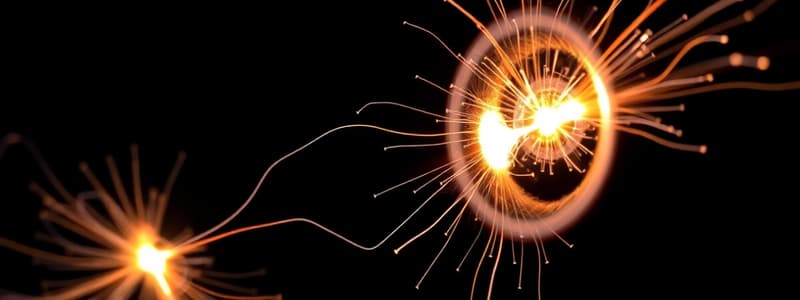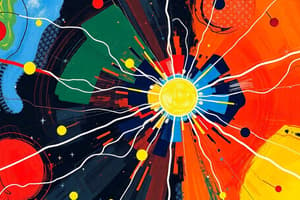Podcast
Questions and Answers
What does Coulomb's Law describe?
What does Coulomb's Law describe?
- The emission of radiation from unstable nuclei
- The behavior of particles at the atomic scale
- The force between two charged objects (correct)
- The motion of bodies in space
Faraday's Law states that a change in electric field induces a magnetic field.
Faraday's Law states that a change in electric field induces a magnetic field.
False (B)
What is the Heisenberg Uncertainty Principle?
What is the Heisenberg Uncertainty Principle?
It states that certain pairs of physical properties cannot be simultaneously known.
The _________ effect describes the emission of electrons from material when exposed to light.
The _________ effect describes the emission of electrons from material when exposed to light.
Match the following key concepts with their descriptions:
Match the following key concepts with their descriptions:
Which equation relates the magnetic field around a conductor to the current flowing through it?
Which equation relates the magnetic field around a conductor to the current flowing through it?
General relativity asserts that gravitational effects are due to the curvature of spacetime.
General relativity asserts that gravitational effects are due to the curvature of spacetime.
What is the significance of Maxwell's Equations?
What is the significance of Maxwell's Equations?
The principle that light exhibits both wave-like and particle-like properties is known as _________.
The principle that light exhibits both wave-like and particle-like properties is known as _________.
Flashcards
Coulomb's Law
Coulomb's Law
Force between charged objects is proportional to the product of their charges and inversely proportional to the square of the distance.
Electric Field (E)
Electric Field (E)
Region around charged object experiencing force; defined as force per unit charge.
Magnetic Field (B)
Magnetic Field (B)
Region around moving charge where other moving charges or magnets experience a force.
Faraday’s Law of Electromagnetic Induction
Faraday’s Law of Electromagnetic Induction
Signup and view all the flashcards
Ampere's Law
Ampere's Law
Signup and view all the flashcards
Quantum Theory
Quantum Theory
Signup and view all the flashcards
Photoelectric Effect
Photoelectric Effect
Signup and view all the flashcards
Wave-Particle Duality
Wave-Particle Duality
Signup and view all the flashcards
Heisenberg Uncertainty Principle
Heisenberg Uncertainty Principle
Signup and view all the flashcards
Study Notes
Electromagnetism
- Definition: Study of electric charges, electric fields, magnetic fields, and their interactions.
- Key Concepts:
- Coulomb's Law: Describes the force between two charged objects; ( F = k \cdot \frac{|q_1 \cdot q_2|}{r^2} ).
- Electric Field (E): A field around a charged object; defined as force per unit charge, ( E = \frac{F}{q} ).
- Magnetic Field (B): A field produced by moving charges; affects other moving charges and magnets.
- Faraday’s Law of Electromagnetic Induction: Change in magnetic field within a closed loop induces an electromotive force (emf).
- Ampere's Law: Relates the magnetic field around a conductor to the current flowing through it; ( \oint B \cdot dl = \mu_0 I ).
- Maxwell's Equations: Set of four fundamental equations governing electromagnetism:
- Gauss's Law for Electricity
- Gauss's Law for Magnetism
- Faraday's Law of Induction
- Ampere-Maxwell Law
- Applications:
- Electromagnets, electric motors, generators, transformers, and more.
Modern Physics
-
Definition: Branch of physics that deals with the behavior of matter and energy at atomic and subatomic levels.
-
Key Concepts:
- Quantum Theory: Describes the behavior of particles at the atomic scale; introduces concepts like quantization of energy.
- Photoelectric Effect: Emission of electrons from material when exposed to light; supports the particle theory of light.
- Wave-Particle Duality: Particles exhibit both wave-like and particle-like properties; described by de Broglie hypothesis.
- Heisenberg Uncertainty Principle: States that certain pairs of physical properties cannot be simultaneously known (e.g., position and momentum).
- Nuclear Physics: Study of atomic nuclei, fundamental particles (protons, neutrons), and their interactions.
- Radioactivity: Process by which unstable nuclei lose energy to gain stability via emission of radiation.
- Relativity: Einstein’s theories of special and general relativity revolutionized the understanding of space, time, and gravity.
- Special Relativity: Deals with the physics of moving bodies and establishes that the speed of light is constant for all observers.
- General Relativity: Gravitational effects are due to the curvature of spacetime caused by mass.
-
Applications:
- Technological advancements (semiconductors, lasers), medical imaging (MRI, PET), nuclear energy, and cosmology.
Electromagnetism
- Electromagnetism is the study of interactions between electric charges, electric fields, magnetic fields and the forces they generate.
- Coulomb's Law describes the force between two charged objects. It states that the force is proportional to the product of the charges and inversely proportional to the square of the distance between them.
- Electric Field is the region around a charged object where other charged objects experience a force. It is defined as the force per unit charge.
- Magnetic Field is a region around a moving charge where other moving charges or magnets experience a force.
- Faraday’s Law of Electromagnetic Induction explains that a changing magnetic field within a closed loop can induce an electromotive force (emf), which can cause electric current to flow.
- Ampere's Law states that the magnetic field around a conductor is proportional to the current flowing through it.
- Maxwell's Equations are a set of four fundamental equations that describe all electric and magnetic phenomena. These equations unify electricity and magnetism, and they are fundamental to our understanding of light and other electromagnetic waves.
Modern Physics
- Modern Physics explores the behavior of matter and energy at the atomic and subatomic levels.
- Quantum Theory describes the behavior of particles at the atomic scale. It introduces the concept of quantization, meaning that energy can only exist in discrete units called quanta.
- The Photoelectric Effect provides evidence for the particle nature of light. It describes the emission of electrons from a material when exposed to light.
- Wave-Particle Duality is the principle that particles exhibit both wave-like and particle-like properties. De Broglie's hypothesis suggests that all matter has wave properties.
- The Heisenberg Uncertainty Principle states that certain pairs of physical properties, such as position and momentum, cannot be accurately known simultaneously.
- Nuclear Physics is the study of the atomic nucleus, consisting of protons and neutrons, and how they interact.
- Radioactivity is the process by which unstable nuclei release energy through the emission of radiation to become stable.
- Relativity is a theory developed by Einstein which revolutionized our understanding of space, time and gravity.
- Special Relativity focuses on the physics of moving bodies and establishes that the speed of light is constant for all observers.
- General Relativity extends special relativity to include gravity, explaining its effects as a result of the curvature of spacetime caused by mass.
Studying That Suits You
Use AI to generate personalized quizzes and flashcards to suit your learning preferences.




